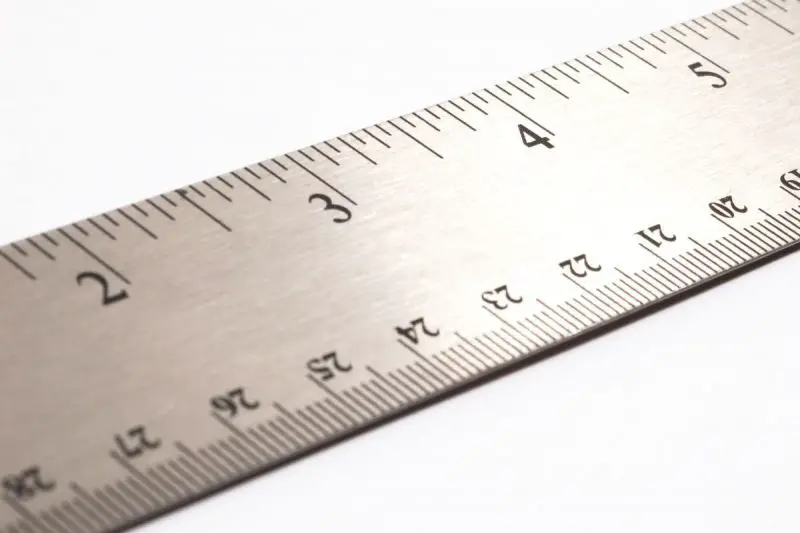Understanding lengths and measurements can be something of an abstract concept, and understanding how big 3 inches actually is can be easier said than done, despite the initial apparent simplicity of this task.
We took a closer look at how big 3 inches actually is, as well as some common items that are the same size.
How Do I Measure Length?
In fact, there are many different ways to measure the length in general, but when it comes to measuring the size of a specific object, such as your thumb or a piece of paper, the main method is to use a ruler.
When you use a ruler, you will need to know what units of measurement you want to use (inches, centimeters, millimeters, etc.), and then you will need to find out which unit corresponds to the size of the object you are trying to measure.
For example, if you were measuring your thumb, you would first have to determine whether you wanted to use inches, centimeters, millimeters, or some other unit.
Then, you would have to find out which inch corresponds to 1 cm, and so on.
The Imperial Measurement System
Inches are part of the imperial measurement system, which originated in England during the Middle Ages.
Measuring in inches originated from the English system of using 12 inches per foot while measuring in centimeters was introduced by the French, who used 10 centimeters for every centimeter.
The metric system has since become more popular, with most countries now adopting the metric system as their official standard. However, both systems are still widely used today.
The imperial measurement system uses a number of units, including feet, yards, miles, cubits, pounds, and ounces.
Before the introduction of the metric system, the British Empire had adopted the imperial system as its primary measurement system.
Today, the United States uses the imperial system exclusively, although Canada, Australia, New Zealand, and several other Commonwealth nations continue to use the metric system alongside the imperial system.
There are many advantages to the imperial measurement system, and these include the fact that it is easy to understand and record, as there are only two basic measurements: feet and inches.
All other measurements are derived from these two base units. This also makes the imperial measurement system simple to calculate.
Another advantage of the imperial measurement system is that it is based on the length of human body parts.
For instance, when calculating the distance between your fingers, you would simply divide the total length of your hand by four (the number of fingers).
This means that all distances within the imperial measurement system are easily calculated.
However, the imperial measurement system does have disadvantages. One disadvantage is that it is not very precise.
It can also make it more difficult to measure small items, such as fractions of an inch.
How Big Is 3 Inches?

So, just how big is 3 inches (see also ‘How Big Is 7 Inches?‘)? Well, the answer depends on which unit you choose to use. If you decide to use inches, then 3 inches equals approximately 2.54 centimeters.
If you decide to go with centimeters, then 3 inches equals about 9.5 mm. And finally, if you decide to go with millimeters, then 3 inches equals roughly 0.0254 meters.
The reason why these three numbers differ is that each unit of measurement has its own unique set of rules regarding how they relate to one another.
To convert centimeters to inches, multiply the given inch value by 2.54 to get the same value in centimeters.
As an example, to convert 7 inches to centimeters, you can multiply 7 by 2.54, giving a centimeter equivalent of 17.78 cm
Which Items Are Three Inches?
There are a number of items that are three inches in size, and these include:
A Standard Nail
A common 3-inch nail is around three inches in size, and this includes the tools that are used for a range of key tasks and projects such as framing and joining pieces of wood.
These nails are usually made out of steel, but they may be made out of other materials such as brass or copper.
A Standard Screwdriver
A standard screwdriver is around three inches long, and this includes the handle and the head of the tool. The head of a standard screwdriver is often metal, but it may also be plastic.
A Credit Card
A credit card is around three inches wide, and this is the standard size for many cards of this type.
Debit and membership cards also tend to follow this standard length, and so these can be used if you do not have a credit card to hand.
A Soup Can
A soup can is around three inches tall, and this is the height of most cans of this type, including Campbell’s, one of the most famous brands of soup in the world.
Half A Dollar Bill
If you fold a dollar bill in half, the resulting shape is usually around 3 inches in width.
This is because the U.S. currency has been standardized at this size for a number of years.
Three Quarters Placed In A Line
When placing three quarters in a line, the result will always be around three inches in length, as each quarter is around 1 inch in width when on its own.
You can therefore place three-quarters side-by-side if you do not have a ruler to hand, and need to measure a distance of three inches.
Three Paper Clips
Three paper clips placed side by side equate to around three inches in length when placed next to each other, as most tend to be around an inch wide.
Half A Hot Dog
The average hot dog is around six inches in diameter, and this means that cutting a hot dog in half will give you a width of roughly three inches, which can be useful as an average guide or estimate.
Hockey Puck
The surface and diameter of a hockey puck is typically around 3 inches across, and this makes it easy to use as a reference point when measuring things.
One Post-It Note
Post-it notes are around three inches in length and width, and they can therefore be used as easy reference points, especially as they can stick well to almost any surface.
Final Thoughts
As you can see from the above list, there are a lot of different items that are three inches long, and some of them are quite useful.
If you want to know how big something is, and need an accurate measurement, then you should try using a tape measure or ruler, as this will help you get accurate results.
For less exact figures, however, you can use the items above as guidelines, and this will allow you to make quick estimates without having to spend too much time getting precise measurements.
- What Size is Regular Printer Paper? Quick Guide for Paper Dimensions - June 18, 2023
- What Size is My Monitor: A Comprehensive Guide - June 18, 2023
- How Big is Italy Compared to the US? A Concise Comparison - June 16, 2023

